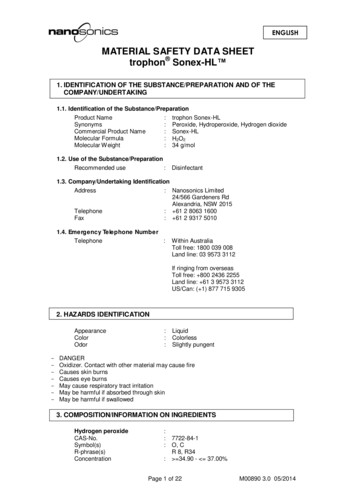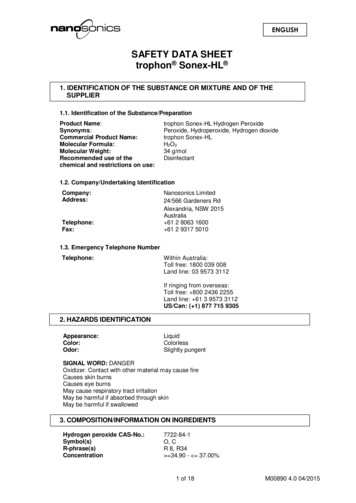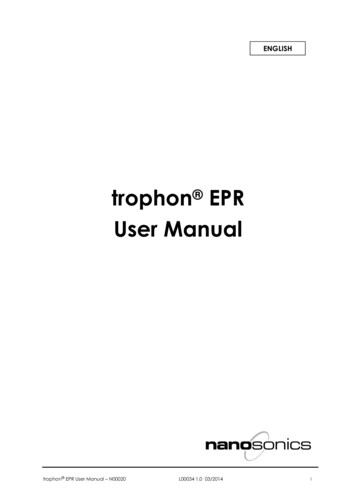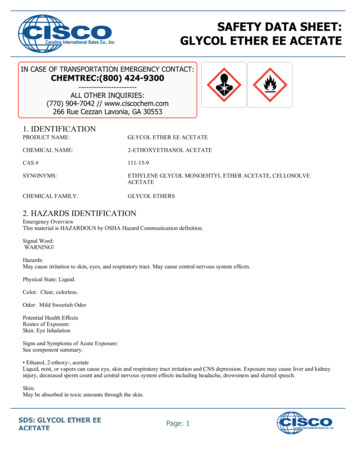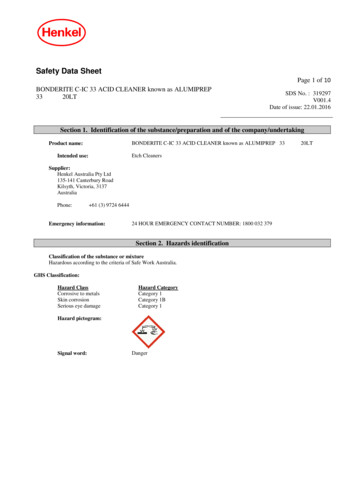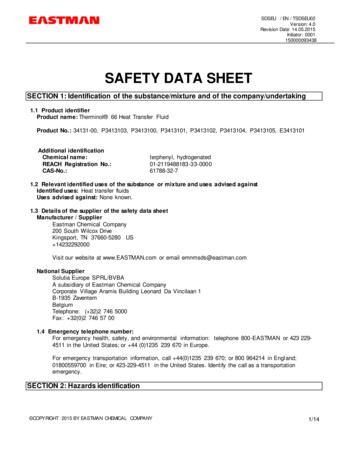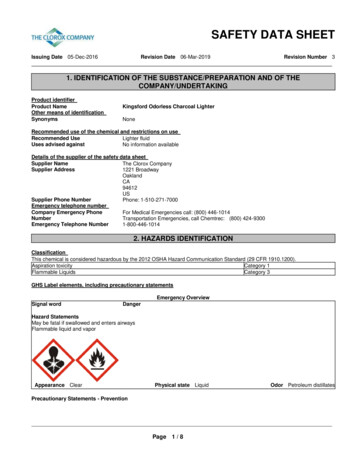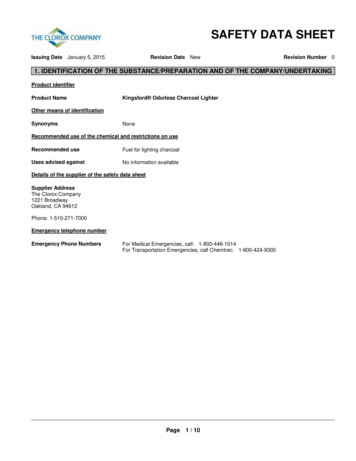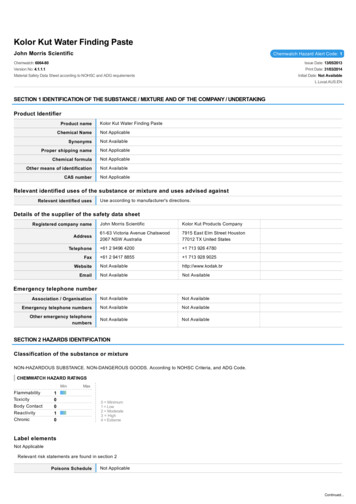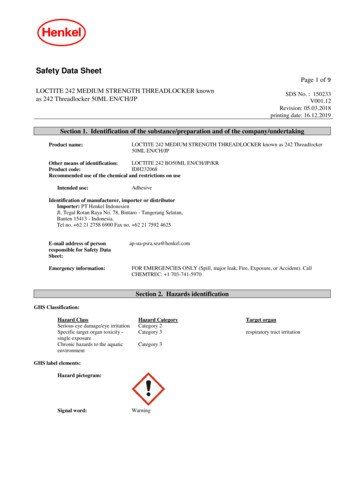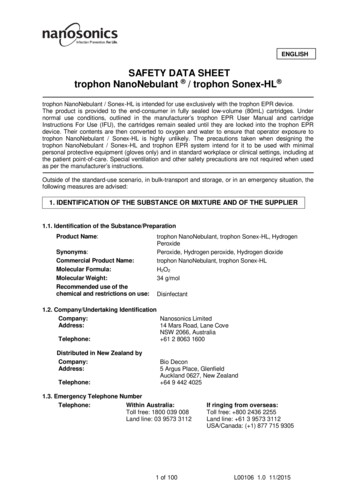
Transcription
ENGLISHSAFETY DATA SHEETtrophon NanoNebulant / trophon Sonex-HL trophon NanoNebulant / Sonex-HL is intended for use exclusively with the trophon EPR device.The product is provided to the end-consumer in fully sealed low-volume (80mL) cartridges. Undernormal use conditions, outlined in the manufacturer’s trophon EPR User Manual and cartridgeInstructions For Use (IFU), the cartridges remain sealed until they are locked into the trophon EPRdevice. Their contents are then converted to oxygen and water to ensure that operator exposure totrophon NanoNebulant / Sonex-HL is highly unlikely. The precautions taken when designing thetrophon NanoNebulant / Sonex-HL and trophon EPR system intend for it to be used with minimalpersonal protective equipment (gloves only) and in standard workplace or clinical settings, including atthe patient point-of-care. Special ventilation and other safety precautions are not required when usedas per the manufacturer’s instructions.Outside of the standard-use scenario, in bulk-transport and storage, or in an emergency situation, thefollowing measures are advised:1. IDENTIFICATION OF THE SUBSTANCE OR MIXTURE AND OF THE SUPPLIER1.1. Identification of the Substance/PreparationProduct Name:Synonyms:Commercial Product Name:Molecular Formula:Molecular Weight:Recommended use of thechemical and restrictions on use:trophon NanoNebulant, trophon Sonex-HL, HydrogenPeroxidePeroxide, Hydrogen peroxide, Hydrogen dioxidetrophon NanoNebulant, trophon Sonex-HLH2O234 g/molDisinfectant1.2. Company/Undertaking IdentificationCompany:Nanosonics LimitedAddress:14 Mars Road, Lane CoveNSW 2066, AustraliaTelephone: 61 2 8063 1600Distributed in New Zealand byCompany:Address:Telephone:Bio Decon5 Argus Place, GlenfieldAuckland 0627, New Zealand 64 9 442 40251.3. Emergency Telephone NumberTelephone:Within Australia:Toll free: 1800 039 008Land line: 03 9573 31121 of 100If ringing from overseas:Toll free: 800 2436 2255Land line: 61 3 9573 3112USA/Canada: ( 1) 877 715 9305L00106 1.0 11/2015
2. HAZARDS IDENTIFICATIONGHS ClassificationOxidising liquids (category 1)Acute toxicity, oral (category 4)Skin irritation (category 1)Serious eye damage/eye irritation (category 1)GHS Label elementOxidiserCorrosiveIrritantSignal word: DangerHazard StatementsH332: Harmful if inhaled.H302: Harmful if swallowed.H315: Causes skin irritation.H318: Causes serious eye damage.H335: May cause respiratory irritation.Precautionary statementsPreventionP261: Avoid breathing dust/ mist/ vapours/ spray.P270: Do not eat, drink or smoke when using this product.P280: Wear protective gloves/protective clothing/eye protection/ face protection.ResponseP301 P312: IF SWALLOWED: Call a POISON CENTER or doctor/ physician if you feel unwell.P302 P352: IF ON SKIN: Wash with plenty of soap and water.P304 P340: IF INHALED: Remove victim to fresh air and keep at rest in a position comfortablefor breathing.P305 P351 P338: IF IN EYES: Rinse cautiously with water for several minutes. Removecontact lenses, if present and easy to do. Continue rinsing.P310: Immediately call a POISON CENTER or doctor/physician.P312: Call a POISON CENTER or doctor/physician if you feel unwell.P330: Rinse mouth.P332 P313: If skin irritation occurs: Get medical advice/attention.P362: Take off contaminated clothing and wash before reuse.P501: Dispose of container in accordance with local/regional/national regulation.3. COMPOSITION/INFORMATION ON INGREDIENTSSubstance ydrogen Peroxide7722-84-1O, CR 8, R35 34.90 - 37.0%4. FIRST AID MEASURESIf inhaledRemove person to fresh air. If not breathing, give artificial respiration.2 of 100L00106 1.0 11/2015
Consult a physician if irritation occurs and persists.In case of skin contactRemove contaminated clothing.Wash with soap and copious amount of water.Consult a physician if irritation occurs and persists.In case of eye contactImmediately rinse thoroughly with plenty of water for at least 15 minutes and seek medicalattention.If swallowedCall a poison control centre or physician immediately. Do NOT induce vomiting unless directedby a physician.If conscious: Rinse mouth thoroughly with water.If unconscious: Never give anything by mouth to an unconscious person.5. FIRE FIGHTING MEASURESSuitable extinguishing mediaFoam, dry powder, carbon dioxide or water spray.Fire / Explosion HazardsProduct is non-combustible. Decomposition releases oxygen which may intensify fire.Special protective equipment for fire-fightersIn the event of a fire, wear self-contained breathing apparatus. Use personal protectiveequipment.Further informationEvacuate personnel to safe areas.Keep unauthorised persons away.Keep out unprotected persons.Use water spray to cool unopened containers.HAZCHEM Code:2P6. ACCIDENTAL RELEASE MEASURESPersonal precautions, protective equipment and emergency proceduresProduct causes chemical burns.Wear personal protective equipment; see section 8.Avoid breathing vapours, mist or gas and ensure adequate ventilation.Evacuate personnel to safe areas.Keep out unprotected persons.Keep away from incompatible products.Environmental precautionsAvoid release into the environment. If the product contaminates rivers, lakes or drains informrespective authorities.Small quantities may be discharged into the sewer when diluted with large quantities of water.Methods and materials for containment and clean upIf possible, dam large quantities of liquid with sand or earth.3 of 100L00106 1.0 11/2015
Dilute with plenty of water.Do not add chemical products.Never return spills to original packaging for re-use.Soak up with inert absorbent material.Dispose of in accordance with local regulations.7. HANDLING AND STORAGEPrecaution for safe handlingAvoid contact with skin and eyes. Avoid inhalation of vapour or mist.Keep away from ignition sources and organics.Use only equipment and materials which are compatible with the product.Conditions for safe storage, including any incompatibilitiesTo maintain product quality:Keep in a cool place (temperature range from -10oC to 25oC for NanoNebulant and 59oF to 77oFfor Sonex-HL).Keep in a dry and well-ventilated area.Keep away from heat and direct sun-light.Keep away from incompatible products.Keep away from combustible material.Keep in original packaging, closed.Keep upright as specified on packaging.Specific use(s)Use only with the trophon EPR.Packaging materialHDPE bottle350um fibre board and ecocoteOther informationRefer to protective measures listed in section 8.8. EXPOSURE CONTROLS/PERSONAL PROTECTIONControl ParametersOccupational Exposal Limits4 of 100L00106 1.0 11/2015
Chemical NameCAS-No.ValueControl parametersBasisHydrogen peroxide7722-84-1TWA1 ppmACGIHTWA1 ppm1.4 mg/m375 ppm IDLHNIOSHTWA1 ppm1.4 mg/m3OSHAEngineering measuresEnsure adequate ventilation. Refer to the personal protective measures below.Personal protective equipmentRespiratory protection:No personal respiratory protective equipment is normally required. However, if workplaceexposure limit is exceeded, apply respiratory protective equipment.Use only respiratory protection that conforms to the international/national standards.Hand protection:Wear suitable gloves.Recommended materials: PVC, rubberEye protection:For normal handling of cartridges, when used with the trophon EPR according to themanufacturers’ instructions, no eye protection is normally required.If in a spill or bulk-handling situation, chemical resistant goggles must be worn.If risk of splashing, chemical proof goggles/face shield must be worn.Skin and body protection:For normal handling of cartridges, when used with the trophon EPR according to themanufacturers’ instructions, body protection is not normally required, except for gloves.If in a spill, bulk-handling or direct chemical contact situation, a protective suit must be worn.If risk of splashing, PVC or rubber apron/boots must be worn.Hygiene measures:Handle in accordance with good hygiene and safety practice.When using, do not eat, drink or smoke.9. PHYSICAL AND CHEMICAL PROPERTIESGeneral Information (appearance, tly pungent5 of 100L00106 1.0 11/2015
Important Health Safety and Environmental InformationpH:1-4Boiling point/range:Flash point:108 C (H2O2 35%)Flammability (solid, gas):Explosive properties:The product is not flammable.Explosive only at high temperatures and when incontact with organic solvents.Oxidizing properties:Vapour pressure:Remarks: OxidizerDoes not flash12 mbar Temperature: 20 CRemarks: Total pressure (H2O2 H2O) (H2O2 50%)72 mbar Temperature: 50 CRemarks: Total pressure (H2O2 H2O) (H2O2 50%)1 mbar Temperature: 30 CRemarks: Partial pressure (H2O2 H2O) (H2O2 50%)Relative density/ Density:Solubility:1.13 (H2O2 35%)Soluble in: WaterPolar organic solventsPartition coefficient (n- octanol/water):Log Pow: -1.1Viscosity:1.07mPa.s Temperature: 20 C (H2O2 27.5%)Vapour density:1 (H2O2 50%)Miscibility in water:Completely miscible10. STABILITY AND REACTIVITYReactivity:Reactive with reducing agents, organic solvents, organic compounds and metals.Chemical Stability:Stable under normal ambient and anticipated storage and handling conditions of temperature andpressure. Contains a stabilizer.Possibility of hazardous reactions:Explosive at high temperatures and when in contact with organic solvents.Conditions to avoid:Direct sunlight and heat.Incompatible materials:Strong acids, strong bases, heavy metal salts, reducing agents and combustible material.Hazardous decomposition products:Oxygen, steam.6 of 100L00106 1.0 11/2015
11. TOXICOLOGICAL INFORMATIONHealth effectsToxicological dataAcute oral toxicity:LD50, rat. 1,232 mg/kg (H2O2 35%)Acute inhalation toxicity:LD50, 4h, rat, 2,000 mg/m3 (Hydrogenperoxide)LC0, 1h, mouse, 2,170 mg/m3 (Hydrogenperoxide)Acute dermal toxicity:LD50, rabbit, 2,000 mg/kg (H2O2 35%)Skin irritation:Rabbit, irritant (skin) (H2O2 50%)Inhalation:Irritation to respiratory tract and can causeinflammation of the respiratory tract andpulmonary oedema.Eye contact:Extreme irritation, watering, redness andswelling of the eyelids.Risk of irreversible damage.Skin contact:Causes caustic burns.Irritation and temporary whitening atcontact area.Ingestion:May lead to bleeding of the mucosa in themouth, oesophagus and stomach.May be fatal if swallowed.Eye irritation:Rabbit, Risk of serious damage to eyes.(H2O2 35%)Sensitization:Guinea pig: not sensitizingChronic toxicity:Oral, prolonged exposure, rat/mouse,Target organs: gastro-intestinal system,observed effectGenetic toxicity in vitro:In vitro, without metabolic activation,mutagenic effects.Genetic toxicity in vivo:In vivo, animal testing did not show anymutagenic effects.12. ECOLOGICAL INFORMATIONEcotoxicityAcute toxicityFishes, Pimephales promelas, LC50, 96h,16.4 mg/lFishes, Pimephales promelas, NOEC, 96h,5 mg/lCrustaceans, Daphnia pulex, EC50, 48h,2.4 mg/lCrustaceans, Daphnia pulex, NOEC, 48h, 1mg/l7 of 100Chronic toxicityRemarks: no data availableAlgae, various species, EC50, from 72 – 96h,from 3.7 – 160 mg/lRemarks: fresh waterAlgae, Nitzchia closterium, EC50, from 72 – 96,0.85 mg/lRemarks: salt waterL00106 1.0 11/2015
Persistence and degradabilityAbiotic degradationAir, indirect photo-oxidation, t 1/2 from 10 20 hConditions: sensitizer: OH radicalsWater, redox reaction, t 1/2 from 2.5 d,10000 ppmConditions: mineral and enzymaticcatalysis, fresh waterWater, redox reaction, t 1/2 from 20 d,100 ppmConditions: mineral and enzymaticcatalysis, fresh waterWater, redox reaction, t 1/2 from 60 hConditions: mineral and enzymaticcatalysis, salt waterSoil, redox reaction, t 1/2 from 15 hConditions: mineral catalysisBiodegradationAerobic, t 1/2 1 minConditions: biological treatment sludgeRemarks: rapid and considerable biodegradationAerobic, t 1/2 from 0.3 - 2 dConditions: fresh waterRemarks: rapid and considerable biodegradationAnaerobicRemarks: not applicableEffects on waste water treatment plants, Inhibitor 200 mg/lRemarks: inhibitory actionBioaccumulative potentiallog Pow -1.1Result: non-bioaccumulable (enzymatic metabolism)Other adverse effectsNot known13. DISPOSAL CONSIDERATIONSWaste from unused productsIn accordance with National, Federal, State and Local regulations.Contaminated packagingEmpty containers should be taken to an approved waste handling site for recycling or disposaland in accordance with National, Federal, State and Local regulations.14. TRANSPORT INFORMATIONMode of transport: Sea, road and rail.Mode of transport to avoid: Air – STRICTLY NO AIR FREIGHT.8 of 100L00106 1.0 11/2015
Other information:HI/UN-No:Transport Hazard Class:Subrisk 1:Packing Group:Proper Shipping Name or Technical Name:Marine Pollutant:IMO Labels:ADG Labels:IMDG EMS Fire:IMDG EMS Spill:HAZCHEM Code:58/20145.1 Oxidizing Agent8 CorrosiveIIHYDROGEN PEROXIDE, AQUEOUSSOLUTIONNoOXIDISING AGENT CORROSIVE5.1 8F-HS-Q2P15. REGULATORY INFORMATIONLabelHazardous components which must be listed on the label: Hydrogen peroxideSymbol(s)CCorrosiveR-phrase(s)R34Causes burnsS1/2Keep locked up and out of the reach of childrenS3Keep in a cool placeS28After contact with skin, wash immediately with plenty of water.S-phrase(s)S36/39Wear suitable protective clothing and eye/face protectionIn case of accident or if you feel unwell, seek medical adviceS45immediately (show the label where possible)See Section 2 for applicable GHS and CLP Hazard and Precautionary StatementsInternational InventoriesToxic Substance Control Act list (TSCA)In compliance with inventory.Australian Inventory of Chemical Substances (AICS)EU list of existing chemical substances (EINECS)New Zealand HSNO regulatory information:HSR001326 class 5.1.1BIn compliance with inventory.In compliance with inventory.In compliance with inventory.The German Federal Water Management ActWater Hazard Class (WHC):ClassHazard PotentialWHC 1Slightly hazardous to water16. OTHER INFORMATIONThe information provided in this Safety Data Sheet is correct to the best of our knowledge,information and belief at the date of its publication. The information given is designed only asguidance for safe handling, use, processing, storage, transportation, disposal and release and isnot to be considered a warranty or quality specification. This applies to the product whichconforms to the specification, unless otherwise stated.Reason for issue: Alignment to GHS requirements9 of 100L00106 1.0 11/2015
FRANÇAISFICHE DE DONNÉES DE SÉCURITÉtrophon NanoNebulant / trophon Sonex-HL trophon NanoNebulant / Sonex-HL est destiné à être utilisé exclusivement avec l’appareil trophonEPR.Le produit est fourni à l’utilisateur final dans des cartouches de faible volume (80 ml) totalementhermétiques. Dans des conditions normales d’utilisation, décrites dans le manuel d’utilisation dutrophon ERP et dans le mode d’emploi de la cartouche du fabricant, les cartouches restent scelléesjusqu’à leur insertion dans l’appareil trophon EPR. Leur contenu est alors converti en oxygène et eneau afin de s’assurer que l’exposition de l’opérateur au trophon NanoNebulant / Sonex-HL esthautement improbable. Les précautions prises lors de la conception du trophon NanoNebulant /Sonex-HL et du système trophon EPR font que ce produit peut être utilisé avec un équipement deprotection individuelle minimal (des gants uniquement) et sur un lieu de travail ou un environnementclinique standard, y compris sur le lieu de soin du patient. Une ventilation et d’autres précautions desécurité spéciales ne sont pas nécessaires selon les instructions du fabricant.Hors du scénario d’utilisation standard, pour un transport et un stockage en vrac, ou dans lessituations d’urgence, les mesures suivantes sont recommandées :1. IDENTIFICATION DE LA SUBSTANCE OU DU MÉLANGE ET DU FABRICANT1.1. Identification de la substance/préparationNom du produit :Synonymes :Nom commercial du produit :Formule moléculaire :Poids moléculaire :Utilisation recommandée de lasubstance chimique etrestrictions liées à l’utilisation :trophon NanoNebulant, trophon Sonex-HL, Peroxyded’hydrogènePeroxyde, peroxyde d’hydrogène, dioxyded’hydrogènetrophon NanoNebulant, trophon Sonex-HLH2O234 g/molDésinfectant10 of 100L00106 1.0 11/2015
1.2. Identification de la société/de l’entrepriseSociété :Nanosonics LimitedAdresse :14 Mars Road, Lane CoveNSW 2066, AustralieTéléphone : 61 2 8063 1600Distribué en Nouvelle-Zélande parSociété :Adresse :Bio Decon5 Argus Place, GlenfieldAuckland 0627, Nouvelle-Zélande 64 9 442 4025Téléphone :1.3. Numéro de téléphone en cas d’urgenceTéléphone :En Australie :Appel gratuit : 1800 039 008Ligne terrestre : 03 9573 3112Depuis l’étranger :Appel gratuit : 800 2436 2255Ligne terrestre : 61 3 9573 3112États-Unis/Canada : ( 1) 877 71593052. IDENTIFICATION DES RISQUESClassification GHSLiquides oxydants (catégorie 1)Toxicité aiguë, orale (catégorie 4)Irritation cutanée (catégorie 1)Grave lésion/irritation oculaire (catégorie 1)Éléments d’étiquette GHS :OxydantCorrosifIrritantMention : DangerPhrases de risqueH332 : Nocif en cas d’inhalation.H302 : Nocif en cas d’ingestion.H315 : Provoque une irritation cutanée.H318 : Provoque de graves lésions oculaires.H335 : Peut provoquer une irritation respiratoire.Mises en garde - StockagePréventionP261 : Éviter de respirer les poussières/brouillards/vapeurs/aérosols.P270 : Ne pas manger, boire ou fumer en lors de l’utilisation de ce produit.P280 : Porter des gants de protection/des vêtements de protection/un équipement de protectiondes yeux/du visage.11 of 100L00106 1.0 11/2015
RéponseP301 P312 : EN CAS D’INGESTION : Appeler un CENTRE ANTIPOISON ou un médecin encas de malaise.P302 P352 : EN CAS DE CONTACT AVEC LA PEAU : Laver abondamment à l’eau et ausavon.P304 P340 : EN CAS D’INHALATION : Amener la victime à l'air frais et la maintenir au reposdans une position confortable pour la respiration.P305 P351 P338 : EN CAS DE CONTACT AVEC LES YEUX : Rincer délicatement à l'eaupendant plusieurs minutes. Retirer les lentilles de contact, le cas échéant et si cela ne présentepas de difficultés. Rinçage continu.P310 : Appeler immédiatement un CENTRE ANTIPOISON ou un médecin.P312 : Appeler un CENTRE ANTIPOISON ou un médecin en cas de malaise.P330 : Rincer la bouche.P332 P313 : En cas d’irritation cutanée : consulter un médecin.P362 : Retirer les vêtements contaminés et les laver avant de les réutiliser.P501 : Le contenant doit être éliminé conformément aux réglementations nationales, régionaleset locales en vigueur.3. COMPOSITION/INFORMATIONS CONCERNANT LES INGRÉDIENTSNom de la substance :N CAS :Symbole(s) :Expression(s) R :Concentration :Peroxyde d'hydrogène7722-84-1O, CR 8, R35 34,90 - 37,0 %4. MESURES DE PREMIERS SECOURSEn cas d'inhalationDéplacer la personne pour lui faire respirer de l'air frais. Pratiquer la respiration artificielle enl’absence de respiration.Si une irritation se produit et persiste, consulter un médecin.En cas de contact avec la peauRetirer les vêtements contaminés.Laver avec du savon et de grandes quantités d'eau.Si une irritation se produit et persiste, consulter un médecin.En cas de contact avec les yeuxRincer immédiatement et complètement avec beaucoup d’eau pendant au moins 15 minutes etconsulter un médecin.En cas d’ingestionAppeler immédiatement le centre antipoison ou un médecin. NE PAS faire vomir sauf si unmédecin le demande.Si la victime est consciente : rincer complètement la bouche à l’eau.Si la victime est inconsciente : Ne jamais faire avaler quelque chose à une personneinconsciente.5. MESURES DE LUTTE CONTRE L’INCENDIEAgents d’extinction appropriésAgent chimique sous forme de mousse, de poudre sèche, dioxyde de carbone ou eaupulvérisée.12 of 100L00106 1.0 11/2015
Risques d’incendie/d’explosionCe produit est non-combustible. La décomposition dégage de l’oxygène qui peut intensifierl’incendie.Équipement de protection spécial pour les pompiersEn cas d’incendie, porter un appareil respiratoire en circ
trophon NanoNebulant / Sonex-HL is intended for use exclusively with the trophon EPR device. The product is provided to the endin fully sealed low-consumer -volume (80mL) cartridges. Under normal use conditions, outlined in the manufacturer’s trophon EPR User Manual and cartridge Instructi
